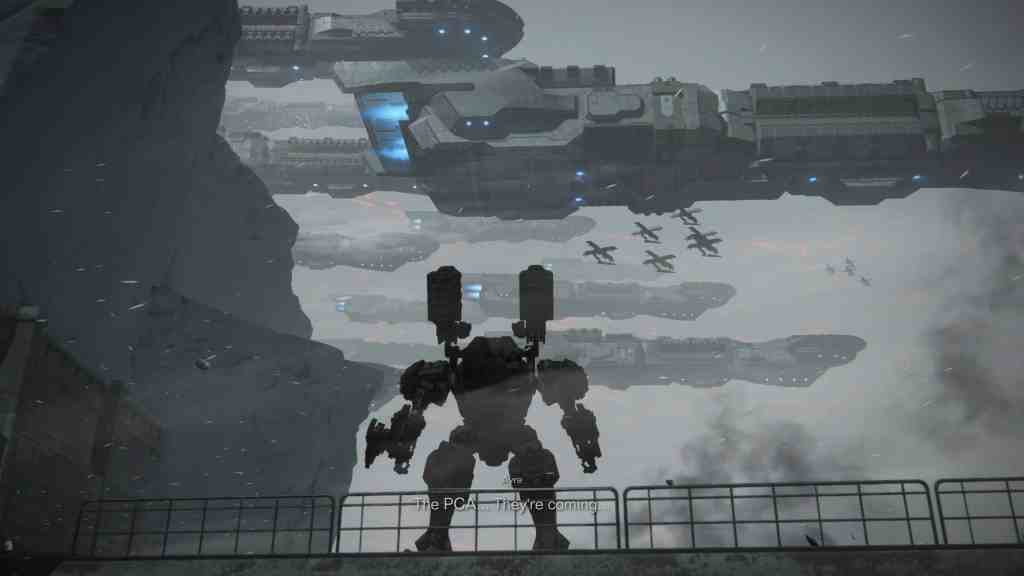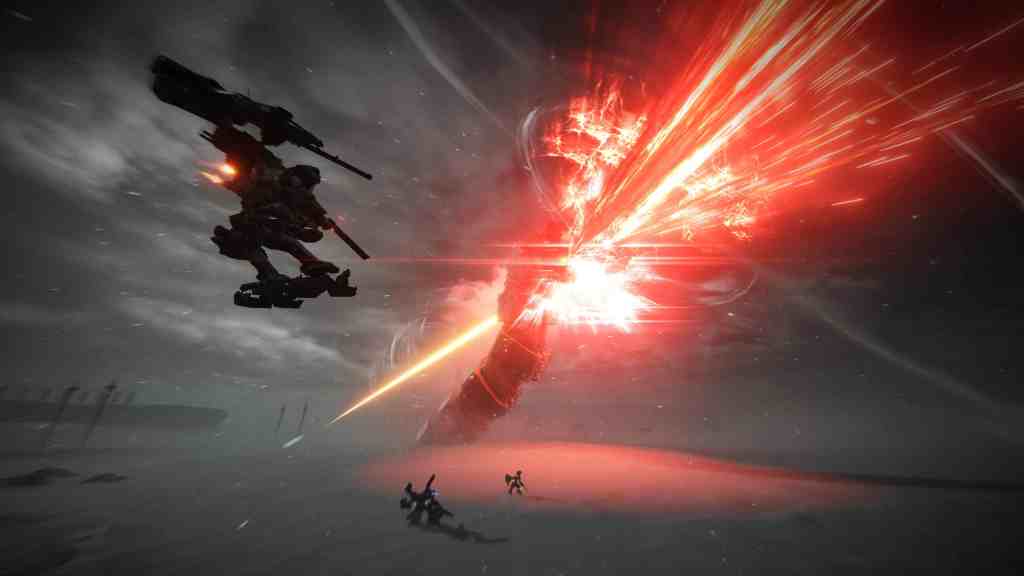In the end, it was the most basic of arsenals that often got me through the greatest challenges of Armored Core 6: Fires of Rubicon.
I would regularly hit a wall on the game’s fearsome chapter-ending bosses, repeatedly trying the encounters over and over again. In one particularly tough case, It felt like my attempts spanned multiple hours over a couple of days. I would put the controller down, return after a long mental reset, and head into the workshop with the intent of completely rebuilding my giant mecha with a different combat approach in mind.

I’d swap out the limbs and parts, and arm it with a completely different suite of weapons and missile launchers to try and eke out some small advantage. Maybe this loadout will work better? Should I go long-range or close-range? Maybe I should stick to an aerial assault? How can I make sure I can nail that pinpoint shot between all those plates of armour? But in my particular case, I was able to eventually surmount most of the game’s greatest obstacles by returning to the versatile basics after so much experimentation: a stock-standard handgun, and the pulse blade I started the game with. That, and some patience.
I’m aware of how dull and discouraging that must all seem from a distance. But for me to look back and think about how daunted I was at the beginning of some of these encounters, and to know that I eventually conquered the seemingly impossible with a no-frills approach (after learning so much more while experimenting) makes me feel quite pleased with myself.

Armored Core 6: Fires of Rubicon comes from FromSoftware, the studio now widely synonymous with challenging games like Elden Ring and the Dark Souls series, with AC6 marking the studio’s return to its beloved, long-dormant mecha series. And for a significant portion of the game, AC6 actually feels more like a traditional power fantasy action game than a Souls-like gauntlet. The highly advanced mecha of your own design can easily annihilate squads of lesser military units with the press of a button, like squashing grapes.
Even though the giant machines have a clear weight and heft, they can also effortlessly boost and fly nimbly around the battlefield with the right parts. With a helpful auto-lock-on and tracking function, it’s a breeze to maintain fast movement, keep your targeting on the enemy, and simultaneously fire off four different weapon sets with ease. You are a one-person demolition crew, and it feels crunchy and glorious. But the effortless nature of many of the missions can be misleading.
Because when those big, challenging encounters come up – only occasionally at first, and then at a more frequent clip as you barrel towards the climax – Armored Core 6 flips into that familiar, Sisyphean FromSoftware mode, taunting you with enormous machines of destruction that fire hundreds of missiles and lasers and bullets at you, causing your mecha’s warning alarm to go off incessantly.

That’s what makes these battles so utterly gratifying to overcome, of course. It’s that feeling of jumping out of your chair when you’ve finally done it. To know that you’ve overcome the challenges presented, whether by your own creative ingenuity with your mecha loadout, or a demonstration of sheer force of will, and skill.
What makes that feeling even more gratifying in Armored Core 6 is the fact that it’s a game with no RPG-style character levelling. You can experiment with different weapons and components to try and exploit enemy weaknesses, and you can upgrade your mecha’s damage output a little bit. But unlike FromSoftware’s Dark Souls or Elden Ring, there’s no way you can back out of an encounter, hack away at lower-level enemies again and again to earn experience, and come back as an overpowering combatant. In Armored Core 6, you and your opponent (at least, in boss fights and mecha duels) will always be on equal footing at best, with the odds stacked way against you at worst.
This means that victories are hard won because you simply performed better. You internalised the attack patterns well enough, or were more focused and reacted more quickly. You were more in sync with your mecha, in the same way I imagine the silent in-game protagonist might feel.

These personal emotions of disheartenment and elation are the strongest you’ll get out of Armored Core 6. The game’s narrative, a story of warring corporations and immoral mercenaries fighting over a destructive and complex energy source, is told exclusively through faceless radio chatter, a decision that makes the storytelling as cold and unfeeling as the hard steel of the mechas and the brutal, industrial dystopia they inhabit.
But there is a tantalising air of intrigue to it all. As is the life of a mercenary for hire, you’ll take on a series of seemingly disjointed missions, hopping between different rival factions (sometimes in consecutive missions), and getting a peek behind both curtains. Like a methodical Cold War spy thriller, the joy is in watching the pieces very slowly move into place, and quietly gasping as you realise what’s going on. To that end, the tone, the aesthetic, the scenario, and the ominous score of Armored Core 6 service this mood very well.
There’s also a benefit to the facelessness of the story in that it also leaves room for you to project your own perception of the characters, an act that creates a unique kind of bond in itself. On the battlefield, many of the missions are short and straightforward, but they also serve the purpose of allowing you to uncover your own revelations about the world and its politics, if you have the perception to find and see things that hint at what’s really going on. A handful of more obvious narrative setpieces exist to create some big peaks during the climax, with both fist-pumping victories and chilling reveals. But like the battles, you get a larger sense of gratification after a little bit of work.

It’s engrossing enough to make you eager to go through it all again once you’re done with the game’s five chapters, though. At certain points throughout the campaign, if you choose to take on one mission ahead of another, certain paths might close off to you because of allegiances or politics, and you won’t get the full picture. Return to play the same missions again in New Game Plus mode – where you retain your equipment and gains from the previous playthrough – and AC6 may dish out a few unexpected surprises during sorties you’ve played through before. The game has no difficulty settings, but it does continue to push you even when you go all the way back to the start.
Armored Core 6 is an unsympathetic and cold-blooded game. It’s a cup of bitter, black coffee – and thankfully, that suits my palate perfectly. It’s full of moments that make you feel very powerful – in both effortless and hard-fought ways – and moments that make you very, very small. And though most of your mysterious comrades have no interest in your well-being, and your goals are far from virtuous, there is ultimately an ongoing theme and atmosphere of defiance as an act of spite. That act of defiance is what keeps you going in Armored Core 6, through icy tundras and charred landscapes, to losing fights with ungodly machines. In the face of it all, you’re pushed to overcome the impossible. And you’ll come out on the other end wearing an exhausted, wry smile.
Five Stars: ★★★★★
Armored Core 6: Fires of Rubicon
Platforms: PC, PS5, PS4, Xbox Series X/S, Xbox One
Developer: FromSoftware
Publisher: Bandai Namco
Release Date: 25 August 2023
|
$33.54
|
|
|
The PlayStation 5 version of Armored Core 6: Fires of Rubicon was provided and played for the purposes of this review. GamesHub reviews are scored on a 5-point rating scale. GamesHub has affiliate partnerships. These do not influence editorial content. GamesHub may earn a small percentage of commission for products purchased via affiliate links.








